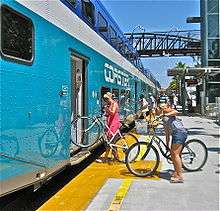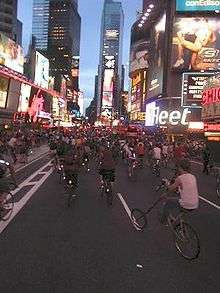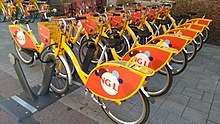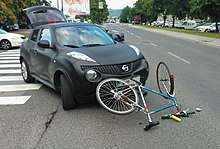Urban cycling
Urban cycling is cycling in built-up areas, typically for distances of a few kilometres. It's usually distinct from cycling as sport (including mountainbiking), tour cycling across long distances, or cycling as a means to "see the landscape" and is often chosen due to being the fastest and/or most economical way around.
Understand
In suburbs and small towns, road traffic is usually modest enough to give space to cyclists. However, street layout may be uncomfortable, especially in places where the "dendritic" cul-de-sac needlessly lengthens all distances.
Accessibility for bicycles in large cities varies a lot, dependent on factors such as infrastructure, terrain, climate and crime. While cities such as Copenhagen and Amsterdam are famously inviting for bicycles, most big cities in the United States are unfavorable.
Old towns are usually less accessible for bicycles. Common problems include cobblestone, stairs and congestion.
Personal electric vehicles need to obey the same laws as bicycles in many jurisdictions. These include electric bicycles, electric scooters (e-scooters), and personal transporters of brands such as Segway and Hoverboard. These are provided by many rental and bikeshare services, as well as for guided tours.
Get around

A bicycle can be used to reach a bus or urban rail station from a suburban location. In some cases, bicycles can be taken on commuter trains or placed on designated racks on buses. Many cities limit your ability to take a bike on a train during rush hour and sometimes you'll have to buy a special ticket for your bike. In the Netherlands train stations usually have guarded bike parking and rental bikes.
The biking environment in the city itself varies quite a lot between cities, also between bike friendly cities.
In some cities (e.g. Copenhagen) there is a bike lane beside the car lanes, transforming into a lane for bikes and right turning cars before each crossing. As bikes and pedestrians are separated and there is no height difference and danger from turning cars at the crossings, speeds can be kept quite high. Bikers are supposed to be adept.
Another model (common in e.g. Finland) is that half the pavement is for bikes. The dividing line is not always respected and one often has to slow down at crossings and at pedestrian congestions. The bike lane can be bidirectional. Look out for people stepping out from buses. Although turning cars should yield, a fast approaching bike is not always noticed in this arrangement.
When bike lanes are missing, bikes may sometimes use the pavement. This is true for children in e.g. Finland. If the children use the pavement and the adults have to adapt to the flow of car traffic, keeping the company together may be difficult. One approach is getting together at each crossing. This will slow you down, but is probably the safest option in many cases.
Biking with the cars can be quite safe for the experienced, if the cars respect cyclists and speeds are low. If the speeds are higher, you can either try to keep to the side and hope cars will leave enough marginals when passing, or keep near the middle of the lane, hindering passing until you give way as needed, at suitable spots. The former approach often works well if there is enough space, the latter if the speed difference is small and cars are respectful. Especially as speeds rise, some motorists may get provoked by your slowing traffic down and try to teach you lessons in dangerous ways. Note local customs and how they work out. Be prepared also for trucks and buses, which need more space than cars and can have a different driving culture.
Often car traffic in cities is congested. If the lanes are wide, a bike can easily keep a higher speed among the cars, but this has its risks. Usually you will turn up from nowhere in the drivers view, and cars will turn, change lanes and open doors to let out a passenger with no respect to you.
Your surprising car drivers is a general problem, especially where bikers are few. The view from the drivers seat is much worse than yours, and they might not look for you. Never count on drivers having noticed you unless you see they have. Increasing your visibility by having bright clothes is good. At dusk lights and reflectors are essential. In some countries it is common for children to have a stick with a small flag at the hight of drivers' eyes.
In most cities there are streets and areas to avoid when getting around by bike, and other streets and areas where biking is pleasant and safe. Some routes may be suitable for getting somewhere fast, others for biking with children or enjoying the surroundings. There may be a city specific logic in how the routes are arranged. If there are biking maps, these are a good start.
Do

"Critical mass" rides are a form of bicycle activism now found around the globe and even in cities where cycling hasn't traditionally been a strong force. What happens is that a group if cyclists get together and ride in such numbers as to practically – and in some cases legally – take over the street. Depending on the country you're in, this may be anything from a grey area of the law to legal as a form of demonstration or protest to born out by the traffic code. Local law enforcement may take any stance from openly sympathetic and supportive to skeptic or even hostile.
Buy or rent
- See also: Cycling#Bike rental
Visitors to another city have the choice to buy a bicycle, rent one, join a bikeshare pool, or take their bike with them.
Bikes for urban areas have somewhat different requirements than those for longer distances or harsher terrain. In general, racing bikes are only a second best option as they're uncomfortable to ride over even slightly non-smooth surfaces which many shortcuts in urban areas can be.
On one hand there is seldom a need for high speeds, as traffic, traffic lights and similar require regularly slowing down. On the other hand, it is a big advantage to be able to accelerate at least as fast as the cars, if driving with them in the street. Three-gear bikes are often adequate for this. Driving upright helps keeping an eye on surrounding traffic.
Bike sharing programs

Hundreds of cities around the world have bike sharing programs for short-term bike rental. Generally speaking such programs consist of at least one (sometimes hundreds of) centrally located bike-rental stations where you can automatically rent bikes with your phone, an app or a special pre-paid card charged to your credit card, your phone bill, your bank account or the aforementioned pre-paid card. Traditionally most cities have offered their own system such as Ecobici in Mexico City or StadtRad Hamburg in Hamburg; however, in recent times some companies have specialized in this kind of service. Most notable among them is Nextbike (operating mostly in Europe, but also in New Zealand) and Call a Bike which belongs to German railway operator Deutsche Bahn. Both are based on a rate per time which is charged by the minute (Call a Bike) or the half hour (Nextbike). In some systems the maximum time you can rent a bike is 24 hours (with rates capped at roughly ten to fifteen Euros a day) but you can return a bike any time you want and get a new one (you have to allow for a short waiting period, typically 0.5–5 minutes).
As this system is still new and many companies are entering the market, expect things to change rapidly and coverage to vary depending on revenue and local politics. Some cities also pay for their bike-rental operator to offer the first x minutes for free. As an example, some systems charge 8 cents per minute (Call a Bike, no discounts) or one Euro per half hour (Nextbike, no discounts), while Nextbike for example offers a discount of roughly fifty percent (with a free first half hour) for a price of three Euros per month valid for all cities and all bicycles operating on the Nextbike system. Call a Bike gives a 25% discount for all BahnCard 25 owners (also good for 25% reduced fares with Deutsche Bahn). Numerous city owned or city run systems give discounts for residents, special offers for tourists (sometimes in combination with public transport discounts) or discounts for owners of week or month tickets for public transport.
Where short time rent is free or very cheap for registered users the system is very flexible: grab a bike, return it to a station near your destination, do your business, grab another bike and move on. Or take a walk and grab a bike just when you feel like.
In the United States (notably) Washington and New York City the systems are more expensive, as more of the revenue is generated through user fees whereas Nextbike earns most of its money through advertising on the bikes and stations as well as local contributions.
Stay safe

Keep in mind that in any collision involving you on a bike and two tons of metal hurling around at 50 km/h (30 mph) you're gonna lose. Unfortunately, motorists can be reckless and some outright hate cyclists and are always eager to "teach them a lesson". Keep your calm and use dedicated infrastructure when possible.
A lot is made of potential for conflict between trams (streetcars) and bikes. This is especially ironic given that the two forms of transport used to dominate major cities before the arrival of the gasoline driven private motorcar. Two things are important to remember: Always cross tracks at a right angle and "see tracks, think train". Where trams have their own right of way, you should stay away from the tracks. Where they share a lane with general traffic, you have just as much right as motorized traffic to use it.
Bike helmets help significantly in some types of crashes: risk of head injuries is diminished to about a third when wearing a helmet. There are, however, studies that show different effects, such as car drivers acting more reckless towards cyclists with a helmet than those without one. Furthermore, a helmet may inhibit your field of vision. Wearing a helmet in places like Copenhagen or Amsterdam marks you immediately and glaringly as an out-of-towner, which has its own problems. The effect on drivers and other people varies quite much from country to country, and sometimes inside a country. Some countries or regions legally require helmets for bicyclists, and in certain places you may well be ticketed if you do not wear one.
There is safety in numbers and cycling is much safer in places where more people do it. Infrastructure is both the number one determinant in how many people cycle and the number one factor in safety. Most serious accidents occur through "dooring" (a car driver smashing their door in your face because they opened it without looking) and crashes at intersections. Both can be drastically reduced through suitable infrastructure.
Cycling is much safer on streets where cars don't exceed 30 km/h (20 mph) than on those where speeds around 50 km/h (30 mph) are the norm. Of course, bike lanes physically separated from high momentum metal boxes are the best for your safety, peace of mind, and riding pleasure.
Cyclists are also exposed to crime, including bike theft, mugging, and runaway crashes.
Severe weather can be dangerous to cyclists — be sure to look up weather reports.
Respect
While bicycles do not pose the imminent danger that cars do, reckless maneuvers provoke other travellers. When there are designated bicycle paths and they are either mandatory to use or safe enough to use when optional, use them.